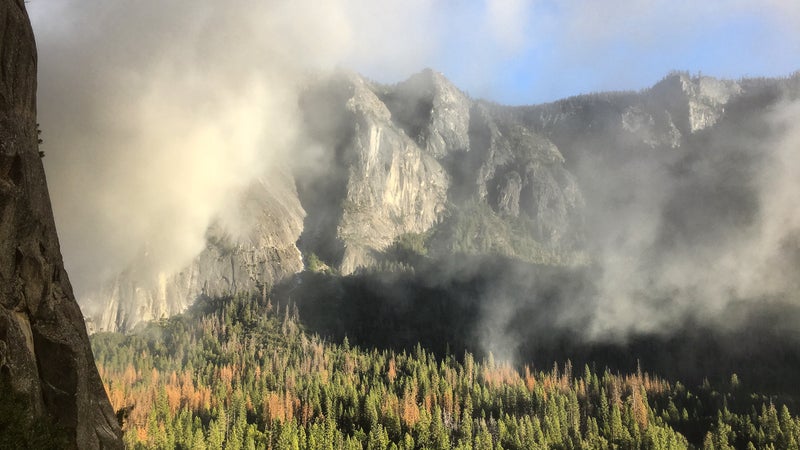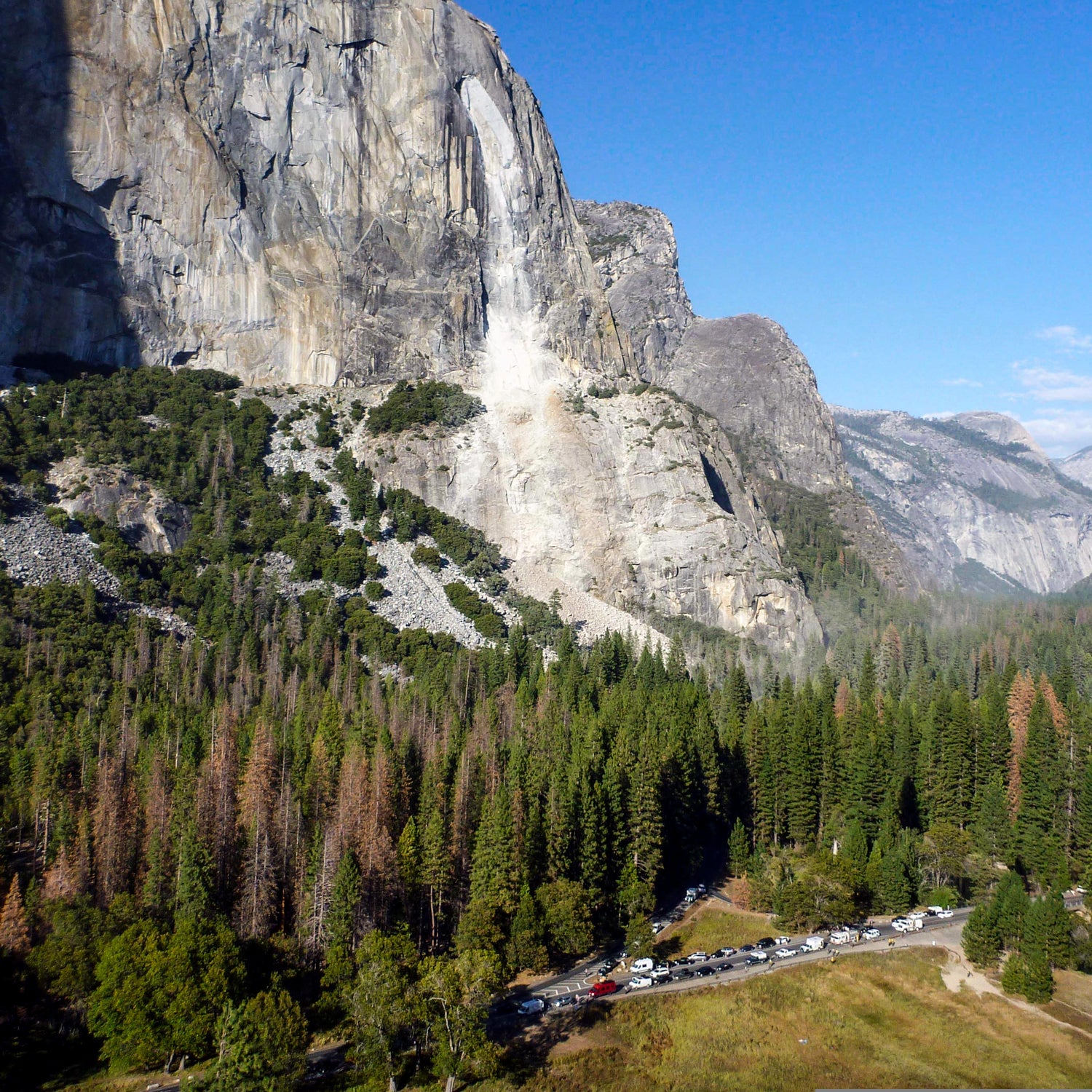My buddy Drew Smith and I are in the Manure Pile parking lot of Yosemite National Park, racking up for a climb. It’s around noon on Wednesday, and tourists are unloading RV’s, families are setting up for lunch on picnic tables, kids are playing tag among��the trees. Just as we��shoulder our backpacks, we��hear a horrible crackling—the sound that makes every climber, no matter where they are, wince, recoil, and look up with squinting eyes.��
A massive piece of granite detaches from the far right face of El Capitan. It drops as if being pulled by some unseen force, dismantling slowly as it glances off the slabs 1,000��feet below. It sounds like a violent thunderclap as it echoes through the valley walls. The flake, or what’s left of it, lands at the base of the wall with a dull thud,��sending rocks of all sizes out into the talus. Boulders roll��before finally settling into place. Gravel and sand pour from the enormous new scar high up on the wall. I hear someone yell for help, but it’s faint. Maybe I’m imagining things. That’s what I tell myself��anyway. A knot forms in my stomach.��
By evening, I’m back at my camp. I have frantic messages from my wife and my dad wondering if I’m okay. News travels fast these days.
A thick, billowing cloud of dust rises over the valley:��the mid-day breeze separates it into spindrifts. The parking lot we’re in is less than a quarter mile from the rockfall, out of harms way. But we’re shaken. The climbing community is small. When something like this happens, there are usually only one or two degrees of separation between an observer and a victim. Drew used to be a member of Yosemite Search and Rescue (YOSAR), and his rescue instincts kick in immediatley. We look around. Surprisingly none of the tourists have noticed the gash in the monolith. No one is even looking up. Kids continue to laugh and play.
Luckily, the far right side of El Capitan rarely gets climbed. It’s notoriously loose. In 2012, while climbing on the opposite side of the Valley, my partner and I witnessed a similar rockfall in the exact same spot, same scenario. No one was hurt then.��Drew and I stare��up at the fresh white scar on El Cap hoping the same is true now. But this one seems to be a lot bigger. We hear sirens. “Shit is going down,” says Drew. “Every SAR member is gonna be called out for this.”
For the next couple hours there are smaller rock falls in the same zone. We can’t see the base from our��vantage point, but we can hear the impact of still more rocks as they hit the talus. Then comes a helicopter. All this—the sirens, the helicopter, the SAR personnel getting dispatched—is��familiar if you’ve been climbing in the Valley long enough. It could mean anything. ����
Drew and I drive to the El Capitan meadow to get a better look at the rockfall. There is a helicopter idling nearby, rescue trucks line the shoulder of the road, and Yosemite park personnel are moving about. A couple of rangers keep the traffic moving and the area clear. The SAR team is debriefing beneath a tree. Our friend, Josh Huckaby, a YOSAR veteran, gives Drew a look that means one thing: bad news.��
��
By evening, I’m back at my camp. I have frantic messages from my wife and my dad wondering if I’m okay. News travels fast these days. Still, the information is hazy. Some reports say it was climbers who were buried under the debris, some say hikers. What we do know: One dead, one injured. I get a message on my Instagram account from a friend in the United Kingdom. He says he’s a good friend of the guy that died, a man named Andrew Foster. Foster was from Wales and worked in sales for Patagonia Inc. Europe. He was not climbing. He and his wife, Lucy, were picking up trash along the base of El Capitan when the rock fell. Andrew didn’t make it. Lucy was rushed to the hospital with a punctured lung and is reportedly in weak��but not critical condition. In the message, my friend writes: “He had just handed in his notice to take a year long, once in a lifetime adventure with Lucy…this was just a holiday and just the beginning.”

The next day, I’m half way up Selaginella, a climb near Yosemite falls, with a different partner, when a thick, white cloud suddenly surrounds us. I get a text from a friend who says the outgoing road has been closed due to another big��rockfall and park personnel are funneling the traffic out the other side of the valley. We assume it is much bigger this time, since we’re about three miles up valley from El Capitan and the dust cloud is dense and easily visible.��
That evening, back��on the ground, I’m able to get more information. The new rockfall was in the same location as Wednesday’s. A 500-foot-long, rectangular piece came off the wall directly above the last one. It’s estimated to be as many��as ten times larger than the others. A driver was reportedly struck in the head when a rock flew through his sunroof. As of this writing, it was��not clear whether��he was��in critical condition or not. That’s the only injury that was reported. The park issued a 24-hour closure on the road.�� ��
Friday morning I have coffee at the SAR site near camp IV. Everyone is talking about the rockfall but it’s in that casual, matter-of-fact way in which first responders recount horrific events. The conversations eventually turn to climbing and other day-to-day things. More coffee is poured. I send a text to my buddy who was on the body recovery team that pulled Foster from the rubble:����
“What are you up to?” I write.��
“Stress debriefing at 10:00,” he responds.��


